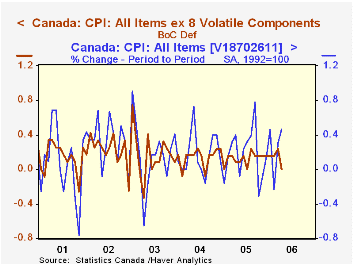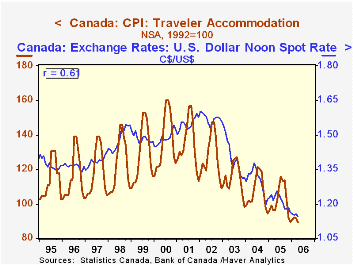 Global| May 18 2006
Global| May 18 2006Canada CPI: Up with Energy, But Restrained by Strong Currency
Summary
Yesterday, the report of US CPI for April set off a firestorm in financial markets as participants were hit with a bad case of inflation-itis. Today's Canadian CPI contained some of the same ingredients, but unlike the US's, Canada's [...]

Yesterday, the report of US CPI for April set off a firestorm in financial markets as participants were hit with a bad case of inflation-itis. Today's Canadian CPI contained some of the same ingredients, but unlike the US's, Canada's "core" rate was actually weaker than expected. The total index was up just under 0.5% for the month, with the yearly rate ahead 2.4%, somewhat more than March's 2.2%. Dramatically, however, its "core" index was unchanged for the month and actually slowed on the year from 1.7% in March to 1.6%.
Canada's "core" inflation is defined by the Bank of Canada and is used directly as a monetary policy target. It excludes eight of the most volatile items, such as fresh fruits and vegetables, gasoline and mortgage interest rates. See the footnote beneath the table for the complete list.
Within the total index, energy prices played a major role in the monthly gain: all energy was up 6.9% (not seasonally adjusted), and separate data on actual retail gasoline prices show an increase of 13.7% to C$1.0675/liter, only the fourth month ever that the price has exceeded C$1.00/liter (the other three instances were just last year: August, September and October).
In discussing the surprising softness of the core measure, some press reports indicated a role for the Canadian dollar. It has strengthened noticeably against the US dollar, not just recently, but basically since the middle of 2002. It also moved up versus the euro from the middle of 2004 through the end of last year. So indeed, the strong currency could be helping Canadian inflation. We look at two components where imports have a significant influence, clothing and recreation. Clothing prices have been falling consistently and in April were 3% below a year earlier. By contrast in the US, the apparel category has declined much less over the last two years. Recreation is another Canadian sector with a trade component, as its residents travel south to Florida and other such destinations and residents of other areas come to Canada. The related prices in Canada are falling slowly, but their pattern changed distinctly soon after the the Canadian dollar turned upward. The chart shows "traveler accommodation" together with the US$ exchange rate; the two series have a remarkable 60% correlation since 1995.
All of Haver's Canadian monthly data are in CANSIM, an extensive collection of Statistics Canada's copyrighted series. Exchange rates can be found in USECON, DAILY, INTDAILY and the weekly counterparts of the latter two, as well as in CANSIM.
| Canada CPI, % Changes* | Apr 2006 | Mar 2006 | Feb 2006 | Year/ Year | December/December|||
|---|---|---|---|---|---|---|---|
| 2005 | 2004 | 2003 | |||||
| All Items | 0.46 | 0.31 | -0.23 | 2.44 | 2.15 | 2.12 | 1.99 |
| All Items less 8 Volatiles** | 0.00 | 0.23 | 0.16 | 1.58 | 1.59 | 1.70 | 2.15 |
| Clothing | -0.50 | -0.70 | -0.69 | -3.02 | -0.93 | -3.10 | 0.20 |
| Recreation, etc. | 0.00 | 0.00 | -0.16 | -0.16 | -0.24 | 0.32 | 0.40 |
| Memo: Can$/US$ Month Avg | 1.1438 | 1.1574 | 1.1489 | 1.2397 (2/2005) | December | ||
| 1.1610 | 1.2191 | 1.3128 | |||||
Carol Stone, CBE
AuthorMore in Author Profile »Carol Stone, CBE came to Haver Analytics in 2003 following more than 35 years as a financial market economist at major Wall Street financial institutions, most especially Merrill Lynch and Nomura Securities. She has broad experience in analysis and forecasting of flow-of-funds accounts, the federal budget and Federal Reserve operations. At Nomura Securites, among other duties, she developed various indicator forecasting tools and edited a daily global publication produced in London and New York for readers in Tokyo. At Haver Analytics, Carol is a member of the Research Department, aiding database managers with research and documentation efforts, as well as posting commentary on select economic reports. In addition, she conducts Ways-of-the-World, a blog on economic issues for an Episcopal-Church-affiliated website, The Geranium Farm. During her career, Carol served as an officer of the Money Marketeers and the Downtown Economists Club. She has a PhD from NYU's Stern School of Business. She lives in Brooklyn, New York, and has a weekend home on Long Island.





